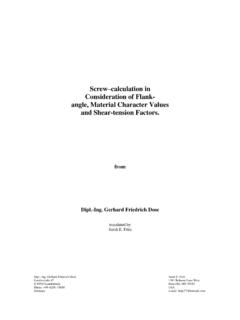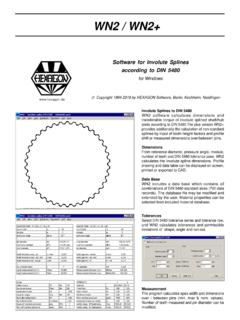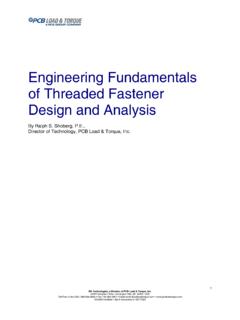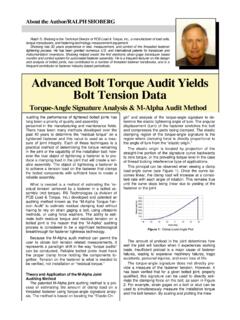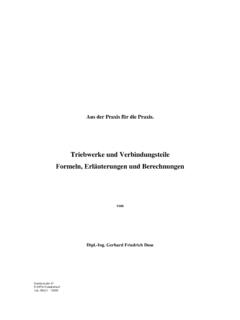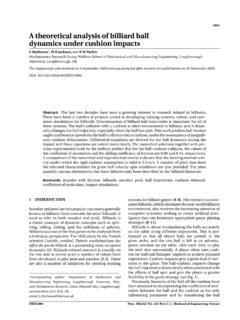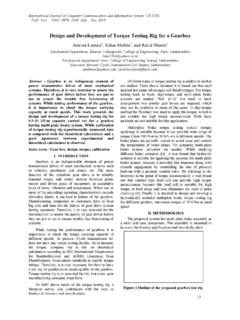Transcription of review design guideline VDI2230fda - HEXAGON
1 RS Technologies, a Division of PCB Load & Torque, Inc. 24350 Indoplex Circle, Farmington Hills, MI 48335 USA Toll-Free in the USA 888-684-2894 Fax:716-684-0987 ISO9001 Certified A2LA Accredited to ISO17025 11th Annual Technical Conference on Fastening Technology Clemson University Radisson Hotel, Cleveland, Ohio, September 9, 1999 review of the Application of design guideline VDI 2230 Using SR1 for PCs Presented by Ralph S. Shoberg, , Director of Technology, PCB Load & Torque, Inc. RS Technologies, a Division of PCB Load & Torque, Inc. 24350 Indoplex Circle, Farmington Hills, MI 48335 USA Toll-Free in the USA 888-684-2894 Fax:716-684-0987 ISO9001 Certified A2LA Accredited to ISO17025 Preliminary Note In the guideline VDI 2230 Part 1, bolted joints are treated which have to transmit constant or alternating working loads and which are designed with high duty bolts.
2 A bolted joint is a separable joint between two or more components using one or more bolts. The bolts must be designed such that the joined section fulfils its allotted function and withstands the working loads occurring. Calculation of the bolted joint aims at determining the required bolt dimensions, allowing for the following influential factors: Strength grade of the bolt Reduction of the assembly preload in the interface or in parts of the interface by the working load Reduction of the assembly preload by embedding Scatter of the preload during tightening Fatigue strength under an alternating load Compressive stress on the clamped parts due to the bolt head and/or the nut. 1 Range of Validity The design rules established in this guideline are valid for steel bolts. The values in the tables are given for the dimension range M4 to M39 and for clamp length ratios lk/d < 10.
3 Bolts with smaller and larger dimensions can be calculated according to the guideline . The given characteristics of materials apply only at room temperature. At higher or lower temperatures allowance must be made for their temperature dependence. Extreme operating stresses such as high and low temperatures outside the given limits, corrosion and impact stresses, are not considered in the present Part 1. The following DIN standards, directives and special regulations should be observed where applicable: DIN 18800 Part 1 Steel Structures, Dimensioning and Construction DIN 18801 High Steel Constructions; Dimensioning, design and Manufacturing DIN 15018 Part 1 to 3 Cranes; Steel Supporting Constructions, Calculation DIN 2505 (preliminary standard) Calculation of Flanged Joints DASt-directive 010 Application of High-strength Bolts in Steel Constructions (published by the German Committee for Steel Construction, Stahlbau-Verlag GmbH, Cologne) AD Note B7 (January 68) Calculation of Pressure Vessels; Bolts AD Note W 7 Materials for Pressure Vessels; Nuts and Bolts in Ferritic Alloy Steels TRD 309 Technical Regulations for Boilers; Bolts (published by the Vereinigung der Techn.)
4 Berwachungsvereine Essen, Beuth-Vertrieb, Berlin) DIN ISO 898 Part 1 and 2 Mechanical Properties of Fasteners DIN 267 Part 1 to 24 Mechanical Fasteners; Technical Delivery Conditions DV 804 (preliminary version) Directive for Railway Bridges and other Engineering Structures VEI 2 Choice of Calculation Approach for Bolted Joints The calculation procedure for a bolted joint is fundamentally dependent on its geometry. More elaborately designed multi-bolted joints must be divided into geometry that is easily handled by the calculation. Fig. 1 shows joint geometry with the relevant applied loads, as well as the suggested calculation procedure. As the formulae are derived from different mechanisms acting during loading, the complexity of the calculation procedure increases according to the complexity of the joint. RS Technologies, a Division of PCB Load & Torque, Inc.
5 24350 Indoplex Circle, Farmington Hills, MI 48335 USA Toll-Free in the USA 888-684-2894 Fax:716-684-0987 ISO9001 Certified A2LA Accredited to ISO17025 Figure 1. Outline of the Bolted Joints For all joints it is assumed that the bolt axes are parallel to each other in the unloaded state, and that they are also parallel to the normal to the interface line. Bulk plastic deformations are excluded. In the micro-geometrical range, plastic deformation is allowed for as preload loss due to embedding. From an evaluation of previous theoretical and experimental work the mechanics of the joint geometry shown in Fig. 1 can be described in the following way. 1. Mechanics of the cylindrical single-bolted joint (geometry (1)). 2. Mechanics of the beam connection (geometry (2) and (3)). 3. Mechanics of the circular plate (geometry (1).)
6 4. Mechanics of the rotation of flanges (geometry (5)). 5. Mechanics of flanged joints with plane bearing face (geometry ((6), (7) and (8)). From an understanding of the actual design of the joint being considered, the design engineer can select the most appropriate calculation method using the idealized models given. 3 Analysis of Force and Deformations The working load on a bolted joint greatly affects the resilience of the entire joint. Therefore, optimum use of highly stressed bolted joints is only possible by means of thorough and exact consideration of the joint's state of forces and deformation. The behavior of forces and deformation in bolted joints is examined in the following terms: Elastic Resilience including the resilience of bolts and the resilience of superimposed clamped parts Load and deformation ratios for directly superimposed parts including the assembled state, the operating state, and special cases.)
7 4 Calculation Steps The calculation of a bolted joint is based on the external working load, FB, acting on the joint. This working load, and the elastic deformations of the component parts which result, cause an axial force, FA, a RS Technologies, a Division of PCB Load & Torque, Inc. 24350 Indoplex Circle, Farmington Hills, MI 48335 USA Toll-Free in the USA 888-684-2894 Fax:716-684-0987 ISO9001 Certified A2LA Accredited to ISO17025 transverse force, FQ, a bending moment, MB, and in some cases a torque moment, MT, at the particular bolt location. The generally difficult and large-scale analysis of forces and deformations, involved in the determination of these initial quantities, cannot be addressed by this guideline because of the large variety of designs of components and bolted joints. These calculations must be made by means of elasto-mechanics.
8 Only for simple symmetrical and relatively stiff joints, can the initial quantities be obtained by a simple analysis of the working load. The values FA, FQ, MB, and MT are subsequently assumed to be known. In Section , the method with calculation steps R1 to R10 is specified, which should mainly be carried out as a preliminary assessment (draft-phase) of bolted joints. It is based on the elementary consideration of the linear dependence of deformations and stresses (linear rule l/l = /E). In contrast, a non-linear relationship for clamp load eccentricity, dependent on FV and FA, is derived in Section , so that all the forces on a bolted joint under equilibrium conditions can be determined. Calculation Procedure for the Basic Linear Case For calculation of the required bolt dimensions, knowing the working load conditions, allowance is made for the following factors: A loss of preload, FZ, in service due to embedding.
9 The assembly preload, FM, is reduced in service by a proportion of the axial bolt force, FPA = (1 - ) FA. To meet certain requirements, , sealing functions, prevention of self-loosening, and prevention of one-sided opening of the interface, a minimum clamp load, FKerf, is necessary in the joint. Finally, allowance is made for the various levels of preload scatter, which will depend upon the assembly method. All of these factors are considered in the main dimensioning formula that forms the basis of the bolt calculation. The assembly preload, FM, in the bolt is a criterion for determining the bolt diameter. FM is the load that, in combination with the thread friction torque produced during tightening, utilizes 90% of the minimum yield strength of the bolt. For a given material strength, the bolt will have clamp load, FM, related to it, which is at least as high as the calculated maximum assembly preload, FMmax.
10 For assembly, the tightening torque, MA, is taken from Tables 1 to 4. When the clamp load, together with the thread torque resulting from tightening, leads to a total stress which reaches 90% of the yield strength or extension limit of the bolt material, the difference force, FSA, resulting from axial force must not exceed AS, so that the extension limit of the bolt is not exceeded: FSA = nFA AS If alternating stresses occur in service, the amplitude of the oscillating force FSAa, must not exceed the endurance limit of the bolt (see calculation step R9). Finally, the calculation procedure also includes a check of the surface pressure under the bolt head or the nut. The limiting surface pressure of the material should not be exceeded in order to avoid preload loss due to creep. The working load, FB, with its axial force and transverse force components, FA and FQ, and under certain circumstances the bending moment, MB, at the bolting point must be given as the initial conditions.

